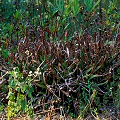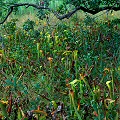Q: What are Location Coded sites like?
A: Below is a description of Location Code sites from
which the ICPS
distributed plants in its conservation program in 2003. For an explanation
of Location Codes, look at the previous web page.
The ICPS will, under no conditions, reveal the identity of these locations. In fact, the ICPS cannot--because I am the ONLY person who knows the sites
that the codes correspond to, and I'm not talking.
Conservation partners that work with the ICPS have the assurance that
they can cooperate with the ICPS in helping distribute plants with Location
Codes and that their sites will stay protected and unrevealed. (The ICPS is
fully aware that if it revealed the identities of the Location Coded sites, it
would never be able to hope for further cooperation with its conservation
partners!)
This is a site in central Alabama that houses Sarracenia alabamensis subsp. alabamensis. The quality of the site is fairly good, with many plants that flower vigorously every year. The plants are growing on the edge of an underground clay dome that squeezes the water to the surface. This site has a reasonable amount of topography---the plants are definitely growing on the side of a hill. The plants tended to be a little on the short side when I saw them, but might have been because the year was very dry. The plants grew among many pine trees, and as a result were a little etiolated in places.

AL002

AL003 AL002
This is a small, flat site in central Alabama that houses Sarracenia alabamensis subsp. alabamensis. The site has a good supply of water (there is even a nicely snake-infested stream nearby), but it is enclosed on all sides by dense vegetation (both native and non-native). With just a few years of neglect, the vegetation could close in on the site. Fortunately, the owners burn the site regularly so this is not (as yet) a problem. The plants at this site are different from the others I have seen in that they tend to form dense clusters of pitchers---each clump is about 60 cm (2 feet) in diameter. The photo to the right shows a single clump early in the season---many dead pitchers from the previous year are still visible.
AL003
This is a large, very gently sloping site in central Alabama that houses Sarracenia alabamensis subsp. alabamensis. The quality of the site is the best I had ever seen---the plants were growing in full sun with plenty of strong light and plentiful water which was squeezed to the surface by an underground clay dome (even during a drought year that I saw it). The plants are really beautiful!
Page citations: Rice, B.A. 2001a; Rice, B.A. 2003a; personal observation.